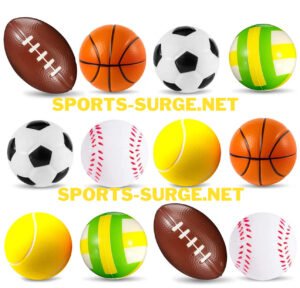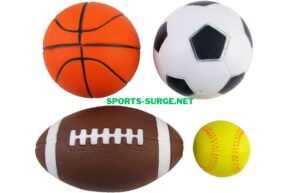Sports balls are fundamental to numerous athletic disciplines, each meticulously designed to enhance performance and meet the specific demands of the game. As of 2024, advancements in materials, technology, and manufacturing processes have significantly transformed these essential pieces of equipment. This comprehensive exploration delves into the evolution, technological innovations, market trends, and future directions of sports balls.
Table of Contents
ToggleEvolution of Sports Balls

The journey of sports balls reflects the broader progression of sports technology and material science:
- Early Constructions: Initially, sports balls were crafted from animal bladders or skins, filled with various materials to achieve the desired shape and firmness. These rudimentary designs often lacked durability and consistency.
- Introduction of Leather: The use of leather coverings improved durability and provided better control. However, leather’s tendency to absorb water led to increased weight during play in wet conditions, affecting performance and safety.
- Synthetic Materials: The mid-20th century saw the adoption of synthetic materials, offering enhanced water resistance and uniformity. This shift allowed for more consistent manufacturing and performance standards across various sports.
Technological Innovations
Recent years have witnessed remarkable technological advancements in sports ball design and functionality:
- Smart Ball Technology: Embedding sensors within balls has revolutionized data collection, providing real-time analytics on metrics such as speed, spin, and trajectory. For instance, the Adidas Al Rihla, used in the 2022 FIFA World Cup, featured connected ball technology that supplied precise ball movement data to assist referees and enhance the viewing experience.
- Advanced Materials: The development of new materials has led to balls that are lighter, more durable, and offer better performance. Innovations include the use of polyurethane and other composites that enhance grip and control while maintaining optimal weight.
- Environmental Considerations: Manufacturers are increasingly focusing on sustainability, utilizing eco-friendly materials and processes to reduce the environmental impact of ball production. This includes the use of recycled materials and non-toxic dyes.
Market Trends

The sports balls market has experienced significant growth, influenced by various factors:
- Market Growth: The global sports balls market was valued at approximately USD 2.54 billion in 2023 and is projected to reach USD 5.67 billion by 2032, growing at a compound annual growth rate (CAGR) of 9.32%.
- Regional Insights: North America holds a substantial market share, with the U.S. ball sports goods market estimated at USD 31.35 billion in 2023, expected to grow at a CAGR of 4.3% from 2024 to 2030.
- Emerging Markets: The Asia-Pacific region is witnessing rapid growth due to increasing participation in sports and rising disposable incomes, leading to higher demand for quality sports equipment.
Sport-Specific Developments

Each sport has unique requirements, leading to specialized advancements in ball design:
- Soccer: The Adidas Al Rihla ball introduced for the 2022 FIFA World Cup incorporated connected ball technology, providing real-time data to enhance decision-making and fan engagement.
- Basketball: The NBA has explored various materials and designs to improve grip and control. Recent developments focus on synthetic composites that mimic the feel of traditional leather while offering better durability and performance consistency.
- Tennis: The tennis ball market is evolving with the adoption of eco-friendly materials and customization options, catering to players’ preferences and environmental concerns.
Future Directions
The future of sports balls is poised for further innovation:
- Integration with IoT: The Internet of Things (IoT) is set to play a significant role, with balls equipped with sensors that connect to devices, providing comprehensive data analytics for players and coaches.
- Personalization: Advancements in manufacturing allow for greater customization, enabling athletes to have equipment tailored to their specific needs, enhancing performance and comfort.
- Sustainability: Ongoing research into sustainable materials aims to produce high-performance balls with minimal environmental impact, aligning with global efforts towards eco-friendly practices.
Conclusion
Sports balls have undergone significant transformations, driven by technological advancements and changing consumer demands. As of 2024, the focus on performance enhancement, data analytics, and sustainability continues to shape the industry, promising exciting developments that will elevate athletic experiences and support the global movement towards more responsible production practices.
FAQs about Sports Balls
What materials are commonly used in the manufacturing of sports balls, and how do they affect performance?
Sports balls are crafted from various materials tailored to the specific demands of each sport:
- Leather: Traditional material offering a natural feel and grip; however, it tends to absorb water, which can affect performance in wet conditions.
- Synthetic Leather: Provides enhanced durability and water resistance, commonly used in soccer balls and basketballs.
- Rubber: Durable and affordable, often used in training balls and sports like basketball and volleyball.
- Polyurethane (PU): Offers a soft touch and high durability, frequently used in premium soccer balls.
- PVC (Polyvinyl Chloride): Known for its durability and affordability, though it may provide a harder touch compared to PU.
The choice of material impacts the ball’s grip, control, durability, and overall performance. For instance, a basketball made with synthetic leather provides better grip and bounce compared to a rubber one.
How does air pressure influence the performance of sports balls?
Air pressure is crucial in determining a ball’s behavior during play:
- Bounce: Proper inflation ensures optimal bounce. Under-inflated balls may have reduced bounce, while over-inflated balls can become too rigid.
- Control: Correct air pressure allows for better control and handling. Deviations can lead to unpredictable ball movement.
- Durability: Maintaining recommended pressure levels helps preserve the ball’s structural integrity over time.
For example, the NBA specifies that basketballs should be inflated to a pressure between 7.5 and 8.5 psi to ensure consistent performance.
What are the standard sizes and weights for different sports balls?
Standard sizes and weights vary across sports to suit their specific requirements:
- Soccer Ball (Size 5): Circumference of 68–70 cm; weight between 410–450 grams.
- Basketball (Size 7): Circumference of 75–76 cm; weight between 567–624 grams.
- Tennis Ball: Diameter of 6.54–6.86 cm; weight between 56.0–59.4 grams.
- Volleyball: Circumference of 65–67 cm; weight between 260–280 grams.
- American Football: Length of 28–30 cm; weight between 397–425 grams.
These specifications are established by respective sports governing bodies to ensure uniformity and fairness in play.
How do environmental factors like temperature and humidity affect sports balls?
Environmental conditions can significantly impact ball performance:
- Temperature: Cold temperatures can reduce a ball’s elasticity, leading to decreased bounce and harder feel. Conversely, higher temperatures can increase elasticity, resulting in a higher rebound.
- Humidity: High humidity levels can cause certain materials, like leather, to absorb moisture, potentially altering the ball’s weight and feel.
Players and officials often adjust ball pressure and storage conditions to mitigate these effects and maintain consistent performance.
What are the regulations regarding the bounce of sports balls in various sports?
Different sports have specific regulations to standardize ball bounce:
- Basketball: The NBA requires that when a basketball is dropped from a height of 1800 mm, it should rebound to a height between 1035 mm and 1085 mm.
- Tennis: The ITF specifies that when a tennis ball is dropped from a height of 100 inches onto a concrete base, it must bounce back to a height between 53 and 58 inches.
- Soccer: FIFA regulations state that when a soccer ball is dropped from a height of 2 meters, it should rebound to a height between 1.1 and 1.2 meters.
These standards ensure consistency in how balls behave during play, allowing athletes to develop and rely on specific skills.
How can I maintain and prolong the lifespan of my sports balls?
Proper maintenance can significantly extend the life of sports balls:
- Regular Cleaning: Remove dirt and debris after use, especially for outdoor balls, to prevent material degradation.
- Proper Storage: Store balls in a cool, dry place away from direct sunlight to prevent material fatigue and discoloration.
- Correct Inflation: Maintain the manufacturer’s recommended air pressure to ensure optimal performance and prevent structural damage.
- Avoid Harsh Surfaces: Using balls on appropriate surfaces reduces unnecessary wear and tear.
By adhering to these practices, athletes can ensure their equipment remains in good condition, providing consistent performance over time.

